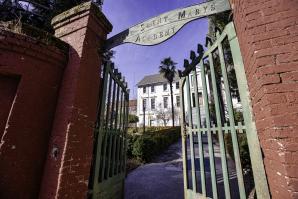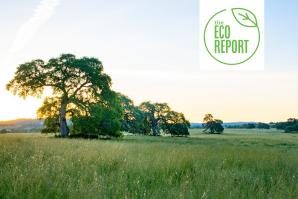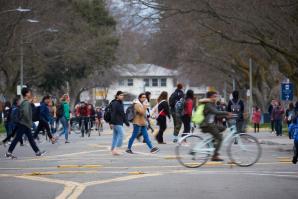A long time ago, the intersection of J Street and Alhambra Boulevard in Sacramento looked quite a bit different.
Today, Miwok Middle School is located on the northeast side of the intersection, with the parking lot for a Safeway grocery store directly across. In the early 1900s, though, each parcel had a graveyard on it: the Jewish burial ground Chevra Kaddisha Cemetery where the parking lot is now; and Sacramento’s first graveyard, New Helvetia Cemetery, at the current middle school site.
“It was described in some of the newspaper articles from the time as just a beautiful area,” says Bob LaPerriere, chair of the Sacramento County Cemetery Advisory Commission, in regard to New Helvetia.
Located in a flood-prone area, each cemetery stopped taking new burials in the early 1900s, and both were removed by about the midpoint of the century.
Elsewhere around the city, cemeteries such as East Lawn in East Sacramento and three adjoining graveyards at Broadway and Riverside Boulevard in Upper Land Park are located near some of Sacramento’s highest-priced real estate. Could any of them be relocated again? We asked local cemetery experts.
‘An outdoor museum’
Lori Bauder manages Sacramento Historic City Cemetery at 1000 Broadway, which is colloquially known as Old City Cemetery and spans 31 acres and roughly 25,000 to 30,000 burials.
The graveyard helps tell the history of the broader region. People buried there include Sacramento city founder John Sutter Jr., transcontinental railroad pioneer Mark Hopkins and multiple survivors of the Donner Party. There are also relatives buried here of Alexander Hamilton and Wyatt Earp.
“This is an outdoor museum, basically,” Bauder says. “It tells the story of the early inhabitants of Sacramento; and their story needs to be told, and it needs to be available.”
The cemetery also functions informally as a park, which was likely by design – 19th century cemeteries like Old City were laid out specifically to function as walking parks. People still go for walks at Sacramento’s historic graveyard and even bring their dogs sometimes. It’s not unlike what people do in older cemeteries in other cities, with ones like the pioneer Lone Fir Cemetery in Portland, Ore. known to draw people out on morning walks.
“One of my father’s favorite things to do when we go out of town is to go find the local cemetery and walk around,” says Stacia Cosgove, a Sacramento city planner. “It’s very peaceful usually, and it does sort of serve that purpose, I would imagine, in a lot of communities.”
New Helvetia Cemetery might have once served this purpose, too. But it was located in a low-lying area near the American River, which left the area prone to flooding. In fact, the cemetery had no burials from 1850-57 because of recurrent flooding, according to a brochure about the graveyard on a county website.
What might have saved the Old City Cemetery for posterity was that for a time, it was the highest point in the city. LaPerriere, who founded a committee at the historic cemetery in the 1980s to help revitalize it, has heard stories of people herding their cattle to the cemetery during flooding in the mid-19th century.
Ornate headstones at New Helvetia were replaced with flat headstones in the early 1900s when the city converted the land into a park. The roughly 5,000 bodies, including prominent figures like Daniel Blue, founder of the city’s first Black church, were disinterred in the 1950s to build what is now Miwok Middle School. Primitive historic preservation practices for those times meaning most went unidentified and were reburied en masse at East Lawn.
“It was in the matter of hundreds that were identified and they were pretty much all buried at the city cemetery in three areas there,” LaPerriere says. “But interestingly enough, until about two years ago, nothing was done to memorialize where they’re buried there.”
Could cemetery removal happen again in Sacramento?
Speaking globally, it’s not unusual for a person’s final resting place to not be quite so final. In parts of Europe like France, Italy and the Netherlands, graves can be leased for as little as 10 years, with bones removed and a gravesite recycled thereafter. Similar practices exist in Asia as well.
Bauder says it can maybe be a good idea when a family has died or moved away and no one is coming to old gravesites anymore to maybe release them. “I think it’s better than building on top of it, in my opinion,” Bauder says. “I think I’d rather have it just be a burial ground and maybe for generations.”
But there is some precedent for removing cemeteries elsewhere, notably in two popular areas of the United States with scant available land.
San Francisco removed its cemeteries during the 20th century, with real estate at a premium in a landlocked city that’s just 46.87 square miles. Instead, San Francisco greats like Joe DiMaggio, Willie Mays and Willie McCovey are buried just south in Colma, which is effectively an entire city that’s a cemetery.
The question is if it could happen again in Sacramento.
“There’s always a chance anywhere,” LaPerriere says. “John Sutter Jr. is here only because his cemetery in Mexico was removed. So this goes on pretty much all over.”
There doesn’t seem to be any momentum, however, for cemetery removal in Sacramento. Prior to her call with Comstock’s for this article, Cosgrove conducted an informal office poll “just to see has anybody fielded a phone call or had an experience related to an existing cemetery being relocated or mothballed or closed up or anything related to that. No one had worked on a project like that before.”
The closet Cosgrove could come up with was Sunset Lawn Chapel of the Chimes, a cemetery and funeral home on Marysville Boulevard, selling some of its excess land — which, to her knowledge, had no burials — to accommodate the building of the Dry Creek Estates residential project.
The willingness to uproot Sacramento’s history also might have shifted in the decades since New Helvetia and Chevra Kaddisha met their demises. “I would like to think it has changed,” Bauder says. “Nobody has ever brought it up.”
LaPerriere has his hopes as well.
“When you destroy a cemetery, you kind of destroy the memory of all those buried there and what they did important-wise to help form the area we live in today,” LaPerriere says. “So basically, it just causes a loss of history, a loss of memory.”
–
Subscribe to the Comstock’s newsletter today.
Recommended For You

Grass Valley Museum Tells Untold History of Women During the Gold Rush
Industrious nuns, international stars and well-educated orphans
In a county known for its wealth of Gold Rush-era museums, undoubtedly some of the most compelling stories from that time reside at a former orphanage hidden within the 160-year-old walls of the Grass Valley Museum.

The Eco Report: Green to the End
Natural cemetery in Lincoln offers environmentally friendly end-of-life options
Imagine selecting your final resting place where bobcats roam,
wildflowers support bees and birds, and trails meander through
rolling grasslands, oak savannah and forested settings.

Onward & Outward
Surrounding cities capitalize off of UC Davis’ growth — and the City of Davis’ slow-growth mindset
UC Davis is a key asset in the Capital Region’s economic development. With the City of Davis’ slow-growth mindset thwarting developments designed to capture tech transfer, surrounding cities look to cash in.





